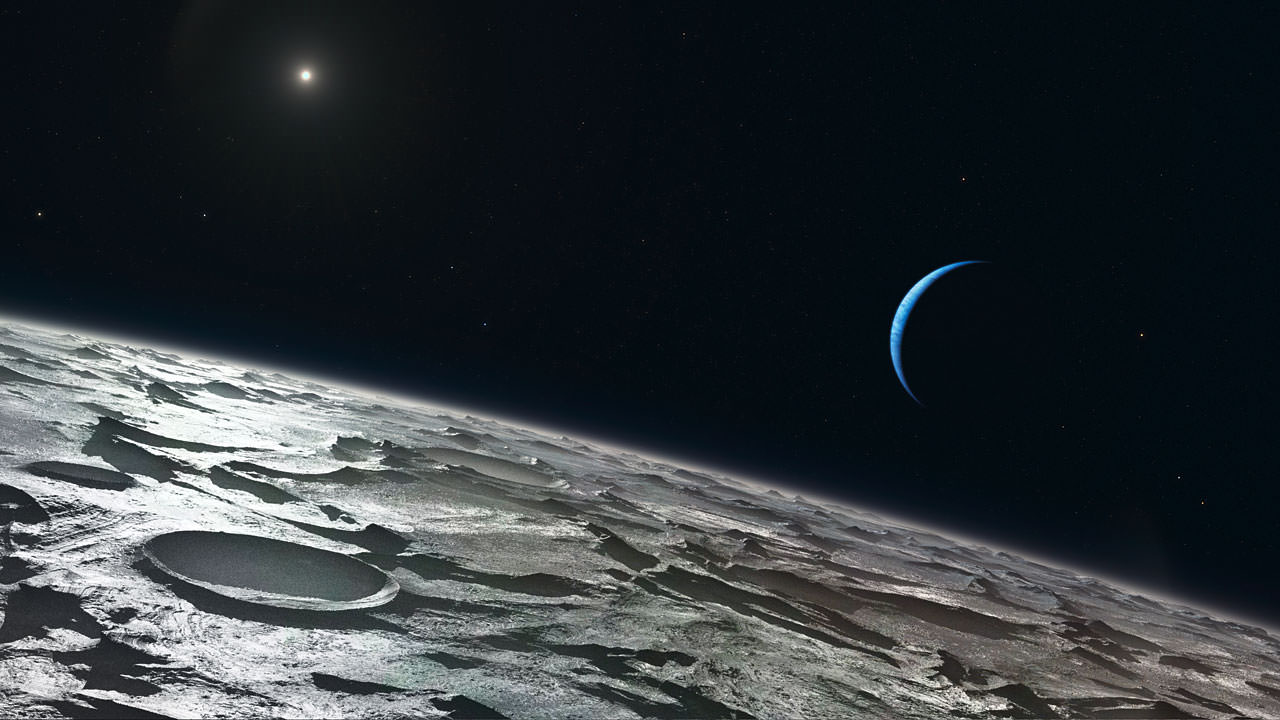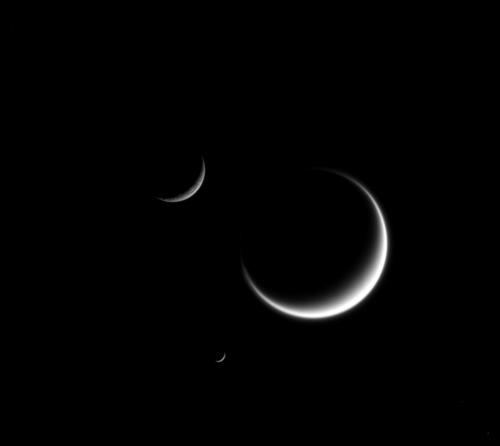In a recent study published in The Planetary Science Journal, a pair of researchers led by The Carl Sagan Center at the SETI Institute in California investigated the potential origin for the thick regolith deposits on Uranus’ moon, Miranda. The purpose of this study was to determine Miranda’s internal structure, most notably its interior heat, which could help determine if Miranda harbors—or ever harbored—an internal ocean.
Continue reading “Scientists Investigate Potential Regolith Origin on Uranus’ Moon, Miranda”Triton’s Arrival was Chaos for the Rest of Neptune’s Moons
The study of the Solar System’s many moons has revealed a wealth of information over the past few decades. These include the moons of Jupiter – 69 of which have been identified and named – Saturn (which has 62) and Uranus (27). In all three cases, the satellites that orbit these gas giants have prograde, low-inclination orbits. However, within the Neptunian system, astronomers noted that the situation was quite different.
Compared to the other gas giants, Neptune has far fewer satellites, and most of the system’s mass is concentrated within a single satellite that is believed to have been captured (i.e. Triton). According to a new study by a team from the Weizmann Institute of Science in Israel and the Southwest Research Institute (SwRI) in Boulder, Colorado, Neptune may have once had a more massive systems of satellites, which the arrival of Triton may have disrupted.
The study, titled “Triton’s Evolution with a Primordial Neptunian Satellite System“, recently appeared in The Astrophysical Journal. The research team consisted of Raluca Rufu, an astrophysicist and geophysicist from the Weizmann Institute, and Robin M. Canup – the Associate VP of the SwRI. Together, they considered models of a primordial Neptunian system, and how it may have changed thanks to the arrival of Triton.
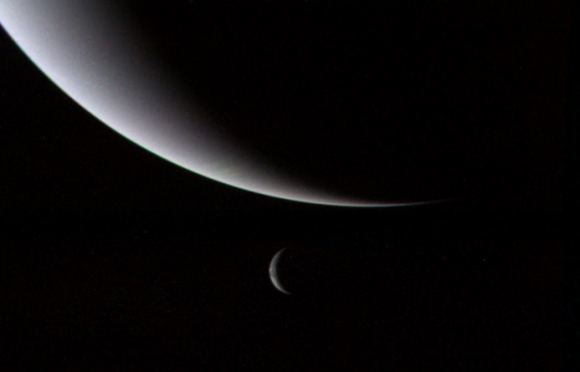
For many years, astronomers have been of the opinion that Triton was once a dwarf planet that was kicked out of the Kuiper Belt and captured by Neptune’s gravity. This is based on its retrograde and highly-inclined orbit (156.885° to Neptune’s equator), which contradicts current models of how gas giants and their satellites form. These models suggest that as giant planets accrete gas, their moons form from a surrounding debris disk.
Consistent with the other gas giants, the largest of these satellites would have prograde, regular orbits that are not particularly inclined relative to their planet’s equator (typically less than 1°). In this respect, Triton is believed to have once been part of a binary made up of two Trans-Neptunian Objects (TNOs). When they swung past Neptune, Triton would have been captured by its gravity and gradually fell into its current orbit.
As Dr. Rufu and Dr. Canup state in their study, the arrival of this massive satellite would have likely caused a lot of disruption in the Neptunian system and affected its evolution. This consisted of them exploring how interactions – like scattering or collisions – between Triton and Neptune’s prior satellites would have modified Triton’s orbit and mass, as well as the system at large. As they explain:
“We evaluate whether the collisions among the primordial satellites are disruptive enough to create a debris disk that would accelerate Triton’s circularization, or whether Triton would experience a disrupting impact first. We seek to find the mass of the primordial satellite system that would yield the current architecture of the Neptunian system.”
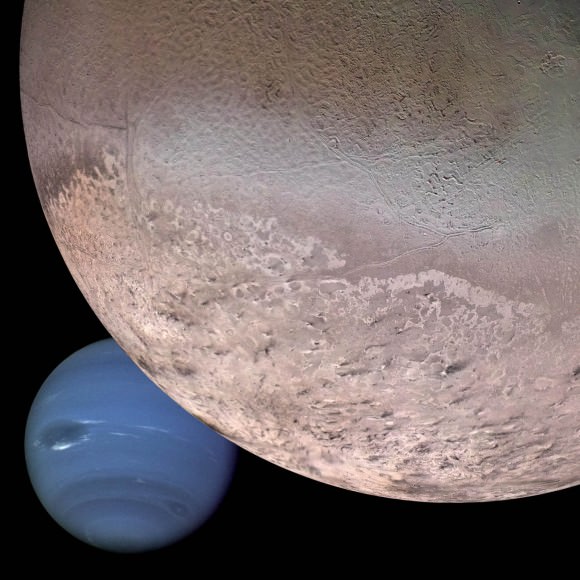
To test how the Neptunian system could have evolved, they considered different types of primordial satellite systems. This included one that was consistent with Uranus’ current system, made up of prograde satellites with a similar mass ration as Uranus’ largest moons – Ariel, Umbriel, Titania and Oberon – as well as one that was either more or less massive. They then conducted simulations to determine how Triton’s arrival would have altered these systems.
These simulations were based on disruption scaling laws which considered how non-hit-and-run impacts between Triton and other bodies would have led to a redistribution of matter in the system. What they found, after 200 simulations, was that a system that had a mass ratio that was similar to the current Uranian system (or smaller) would have been most likely to produce the current Neptunian system. As they state:
“We find that a prior satellite system with a mass ratio similar to the Uranian system or smaller has a substantial likelihood of reproducing the current Neptunian system, while a more massive system has a low probability of leading to the current configuration.”
They also found that the interaction of Triton with an earlier satellite system also offers a potential explanation for how its initial orbit could have been decreased fast enough to preserve the orbits of small irregular satellites. These Nereid-like bodies would have otherwise been kicked out of their orbits as tidal forces between Neptune and Triton caused Triton to assume its current orbit.
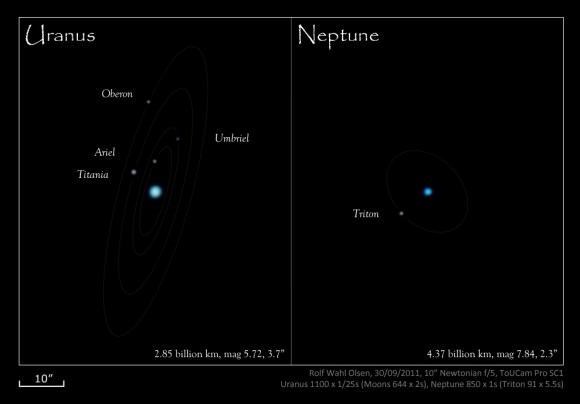
Ultimately, this study not only offers a possible explanation as to why Neptune’s system of satellites differs from those of other gas giants; it also indicates that Neptune’s proximity to the Kuiper Belt is what is responsible. At one time, Neptune may have had a system of moons that were very much like those of Jupiter, Saturn, and Uranus. But since it is well-situated to pick up dwarf planet-sized objects that were kicked out of the Kuiper Belt, this changed.
Looking to the future, Rufu and Canup indicate that additional studies are needed in order to shed light on Triton’s early evolution as a Neptunian satellite. Essentially, there are still unanswered questions concerning the effects the system of pre-existing satellites had on Triton, and how stable its irregular prograde satellites were.
These findings were also presented by Dr, Rufu and Dr. Canup during the 48th Lunar and Planetary Science Conference, which took place in The Woodlands, Texas, this past March.
Further Reading: The Astronomical Journal, USRA
Moonspotting-A Guide to Observing the Moons of the Solar System
Like splitting double stars, hunting for the faint lesser known moons of the solar system offers a supreme challenge for the visual observer.
Sure, you’ve seen the Jovian moons do their dance, and Titan is old friend for many a star party patron as they check out the rings of Saturn… but have you ever spotted Triton or Amalthea?
Welcome to the challenging world of moon-spotting. Discovering these moons for yourself can be an unforgettable thrill.
One of the key challenges in spotting many of the fainter moons is the fact that they lie so close inside the glare of their respective host planet. For example, +11th magnitude Phobos wouldn’t be all that tough on its own, were it not for the fact that it always lies close to dazzling Mars. 10 magnitudes equals a 10,000-fold change in brightness, and the fact that most of these moons are swapped out is what makes them so tough to see. This is also why many of them weren’t discovered until later on.
But don’t despair. One thing you can use that’s relatively easy to construct is an occulting bar eyepiece. This will allow you to hide the dazzle of the planet behind the bar while scanning the suspect area to the side for the faint moon. Large aperture, steady skies, and well collimated optics are a must as well, and don’t be afraid to crank up the magnification in your quest. We mentioned using such a technique previously as a method to tease out the white dwarf star Sirius b in the years to come.
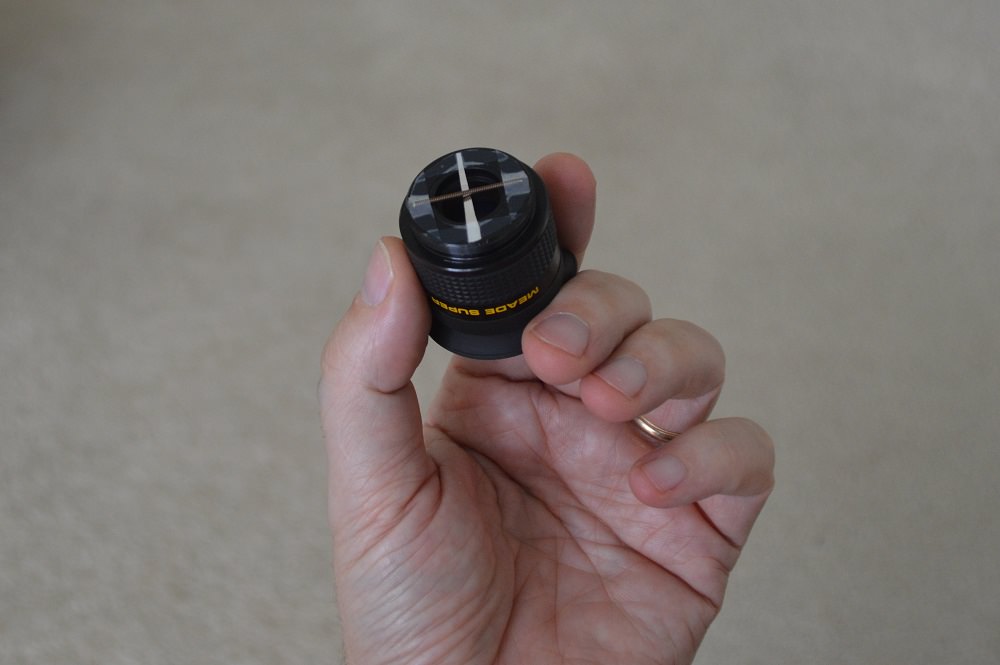
What follows is a comprehensive list of the well known ‘easy ones,’ along with some challenges.
We included a handy drill down of magnitudes, orbital periods and maximum separations for the moons of each planet right around opposition. For the more difficult moons, we also noted the circumstances of their discovery, just to give the reader some idea what it takes to see these fleeting worlds. Remember though, many of those old scopes used speculum metal mirrors which were vastly inferior to commercial optics available today. You may have a large Dobsonian scope available that rivals these scopes of yore!
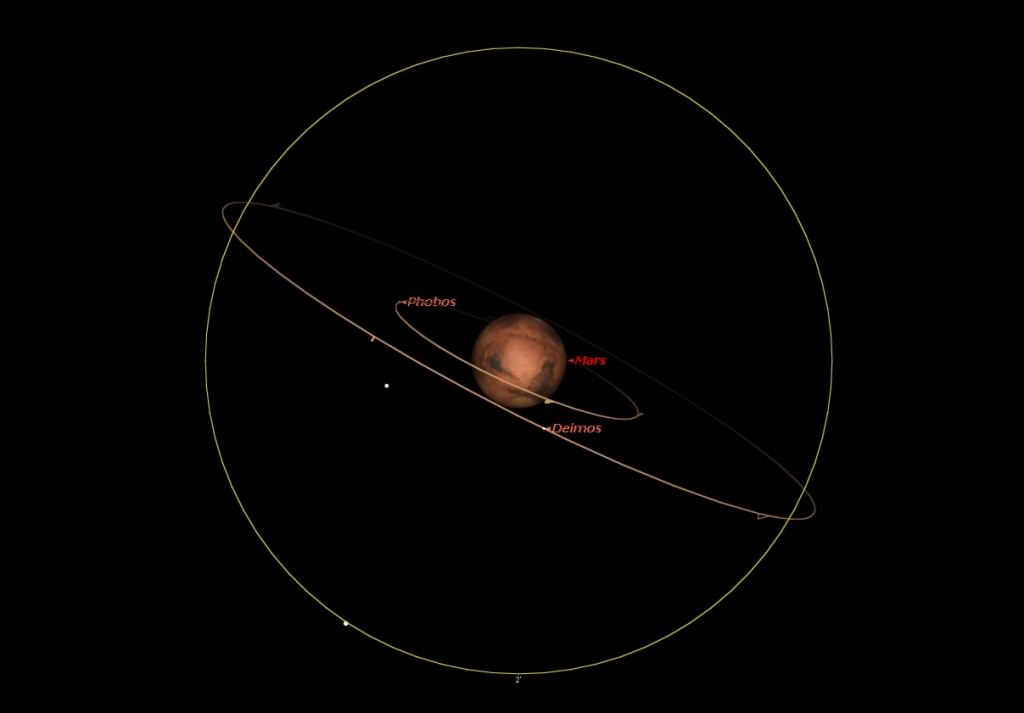
Mars- The two tiny moons of Mars are a challenge, as it’s only possible to nab them visually near opposition, which occurs about once every 26 months. Mars next reaches opposition on May 22nd, 2016.
Phobos:
Magnitude: +11.3
Orbital period: 7 hours 39 minutes
Maximum separation: 16”
Deimos:
Magnitude: +12.3
Orbital period: 1 day 6 hours and 20 minutes
Maximum separation: 54”
The moons of Mars were discovered by American astronomer Asaph Hall during the favorable 1877 opposition of Mars using the 26-inch refracting telescope at the U.S. Naval Observatory.
Jupiter- Though the largest planet in our solar system also has the largest number of moons at 67, only the four bright Galilean moons are easily observable, although owners of large light buckets might just be able to tease out another two. Jupiter next reaches opposition March 8th, 2016.
Ganymede:
Magnitude: +4.6
Orbital period: 7.2 days
Maximum separation: 5’
Callisto
Magnitude: +5.7
Orbital period: 16.7 days
Maximum separation: 9’
Io
Magnitude: +5.0
Orbital period: 1.8 days
Maximum separation: 1’ 50”
Europa
Magnitude: +5.3
Orbital period: 3.6 days
Maximum separation: 3’
Amalthea
Magnitude: +14.3
Orbital period: 11 hours 57 minutes
Maximum separation: 33”
Himalia
Magnitude: +15
Orbital period: 250.2 days
Maximum separation: 52’
Note that Amalthea was the first of Jupiter’s moons discovered after the four Galilean moons. Amalthea was first spotted in 1892 by E. E. Barnard using the 36” refractor at the Lick Observatory. Himalia was also discovered at Lick by Charles Dillon Perrine in 1904.
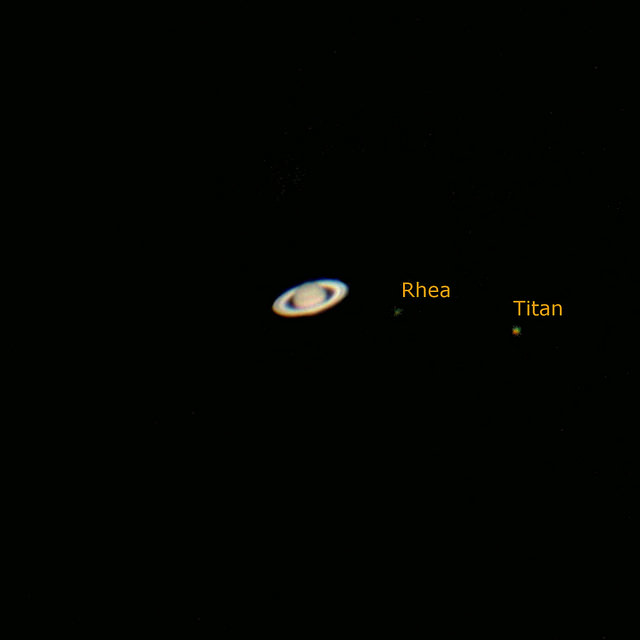
Saturn- With a total number of moons at 62, six moons of Saturn are easily observable with a backyard telescope, though keen-eyed observers might just be able to tease out another two:
(Note: the listed separation from the moons of Saturn is from the limb of the disk, not the rings).
Titan
Magnitude: +8.5
Orbital period: 16 days
Maximum separation: 3’
Rhea
Magnitude: +10.0
Orbital period: 4.5 days
Maximum separation: 1’ 12”
Iapetus
Magnitude: (variable) +10.2 to +11.9
Orbital period: 79 days
Maximum separation: 9’
Enceladus
Magnitude: +12
Orbital period: 1.4 days
Maximum separation: 27″
Dione
Magnitude: +10.4
Orbital period: 2.7 days
Maximum separation: 46”
Tethys
Magnitude: +10.2
Orbital period: 1.9 days
Maximum separation: 35”
Mimas
Magnitude: +12.9
Orbital period: 0.9 days
Maximum separation: 18”
Hyperion
Magnitude: +14.1
Orbital period: 21.3 days
Maximum separation: 3’ 30”
Phoebe
Magnitude: +16.6
Orbital period: 541 days
Maximum separation: 27’
Hyperion was discovered by William Bond using the Harvard observatory’s 15” refractor in 1848, and Phoebe was the first moon discovered photographically by William Pickering in 1899.

Uranus- All of the moons of the ice giants are tough. Though Uranus has a total of 27 moons, only five of them might be spied using a backyard scope. Uranus next reaches opposition on October 12th, 2015.
Titania
Magnitude: +13.9
Orbital period:
Maximum separation: 28”
Oberon
Magnitude: +14.1
Orbital period: 8.7 days
Maximum separation: 40”
Umbriel
Magnitude: +15
Orbital period: 4.1 days
Maximum separation: 15”
Ariel
Magnitude: +14.3
Orbital period: 2.5 days
Maximum separation: 13”
Miranda
Magnitude: +16.5
Orbital period: 1.4 days
Maximum separation: 9”
The first two moons of Uranus, Titania and Oberon, were discovered by William Herschel in 1787 using his 49.5” telescope, the largest of its day.
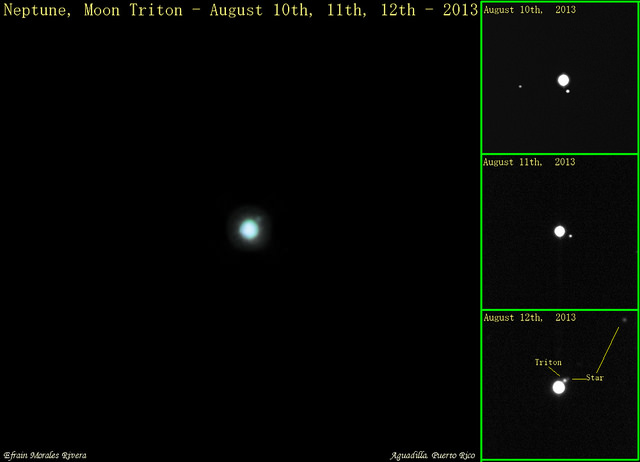
Neptune- With a total number of moons numbering 14, two are within reach of the skilled amateur observer. Opposition for Neptune is coming right up on September 1st, 2015.
Triton
Magnitude: +13.5
Orbital period: 5.9 days
Maximum separation: 15”
Nereid
Magnitude: +18.7
Orbital period: 0.3 days
Maximum separation: 6’40”
Triton was discovered by William Lassell using a 24” reflector in 1846, just 17 days after the discovery of Neptune itself. Nereid wasn’t found until 1949 by Gerard Kuiper.
Pluto-Yes… it is possible to spy Charon from Earth… as amateur astronomers proved in 2008.
Charon
Magnitude: +16
Orbital period: 6.4 days
Maximum separation: 0.8”
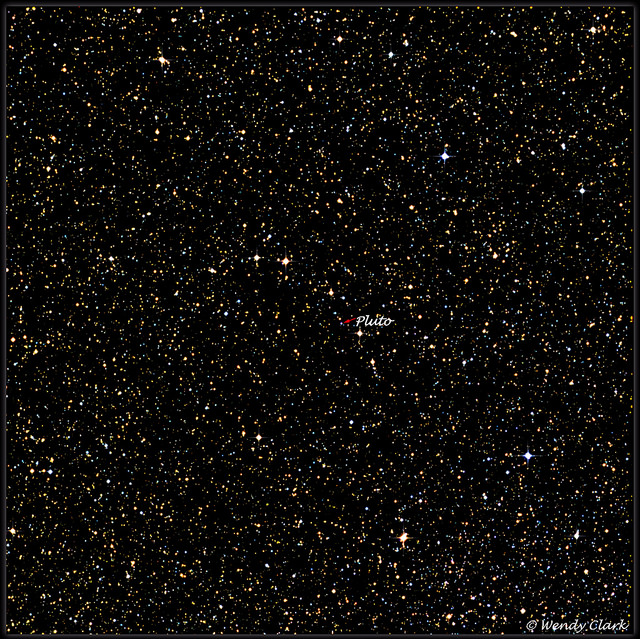
In order to cross off some of the more difficult targets on the list, you’ll need to know exactly when these moons are at their greatest elongation. Sky and Telescope has some great apps in the case of Jupiter and Saturn… the PDS Rings node can also generate corkscrew charts of lesser known moons, and Starry Night has ‘em as well. In addition, we tend to publish cork screw charts for moons right around respective oppositions, and our ephemeris for Charon elongations though July 2015 is still active.
Good luck in crossing off some of these faint moons from your astronomical life list!


